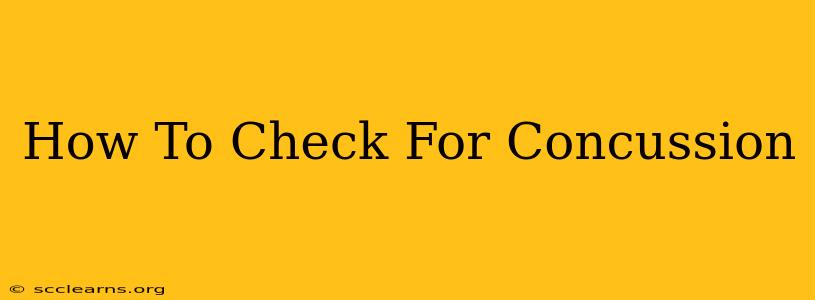A concussion is a type of traumatic brain injury (TBI) caused by a bump, blow, or jolt to the head or body that causes the brain to move rapidly back and forth inside the skull. This can result in a change in brain function. Recognizing the signs and symptoms of a concussion is crucial for prompt treatment and preventing long-term complications. This guide will walk you through how to check for concussion effectively.
Understanding the Signs and Symptoms of Concussion
Concussion symptoms can vary greatly from person to person, and they may not always be immediately apparent. Some individuals might experience mild symptoms, while others may have more severe effects. It’s vital to be aware of both immediate and delayed symptoms.
Immediate Symptoms (occurring right after the injury):
- Loss of consciousness: While not always present, this is a significant indicator.
- Confusion or disorientation: Difficulty remembering events, feeling dazed or foggy.
- Headache: A persistent and often severe headache.
- Dizziness: Feeling unsteady or lightheaded.
- Nausea or vomiting: Feeling sick to your stomach.
- Balance problems: Difficulty walking or maintaining balance.
- Blurred vision: Difficulty seeing clearly.
- Sensitivity to light or noise: Experiencing discomfort in bright light or loud sounds.
- Ringing in the ears (tinnitus): A persistent ringing sensation.
Delayed Symptoms (appearing hours, days, or even weeks later):
- Persistent headache: A headache that doesn't go away.
- Sleep disturbances: Difficulty sleeping or sleeping too much.
- Irritability: Increased moodiness or emotional sensitivity.
- Fatigue: Feeling unusually tired or sluggish.
- Concentration problems: Difficulty focusing or remembering things.
- Memory problems: Trouble recalling recent events.
- Emotional changes: Significant mood swings, anxiety, or depression.
- Changes in personality: Noticeable differences in behavior or personality.
How to Check Someone for a Concussion: The SCAT5 Tool
While not a substitute for professional medical evaluation, the Sport Concussion Assessment Tool, 5th edition (SCAT5) is a widely used tool to help assess concussion risk. It's not something you can easily access online for full use but its principles can help guide you. Key elements include:
- Observation: Look for any signs of injury, unusual behavior, or altered consciousness.
- Cognitive assessment: Ask simple questions to evaluate orientation, memory, and concentration. Examples include asking the date, location, and what happened.
- Balance assessment: Observe their ability to stand with feet together, eyes closed (observe for swaying).
- Symptom evaluation: Ask about any of the symptoms listed above. Use a rating scale (often 0-6 or similar) for each symptom to gauge severity.
When to Seek Immediate Medical Attention
If you suspect a concussion, seek immediate medical attention in the following situations:
- Loss of consciousness: Even brief loss of consciousness warrants immediate medical evaluation.
- Severe headache: A progressively worsening headache.
- Seizures: Any uncontrolled muscle spasms.
- Vomiting: Persistent vomiting.
- Weakness or numbness: Weakness or numbness in any part of the body.
- Difficulty breathing: Trouble catching your breath.
- Changes in behavior: Significant and concerning changes in personality or behavior.
- Deteriorating symptoms: Symptoms that worsen over time.
Note: This information is for educational purposes only and should not be considered medical advice. Always consult with a qualified healthcare professional for any concerns about a concussion. Early diagnosis and appropriate management are crucial for optimal recovery.

